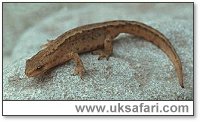
|

|
|
 Sent
to you Sent
to you
by e-mail
|
|
Simply
enter your details and hit the send button
more
info |
|


Click Here

Links
Advertise
Terms of Use
Contributors
About Us
Contact Us
|
 |
Go back
 | Bookmark
| Bookmark
 | Print Page
| Print Page  | E-Mail Us
| E-Mail Us 
 

Photo: G. Bradley
|
|
UK
Safari Tip:
Need help identifying amphibians and reptiles? Try this superbly
illustrated fold out ID chart - click
here
|
|
Latin name: Triturus vulgaris
Size: Smooth newts grow to a length of around 9cms.
Distribution: Found throughout the UK.
Months seen: March to October.
Life Span: Approximately 5 years
Habitat: They can be found in, or near, ponds and streams during spring and summer. In early October they come out of the water to hibernate on dry land through to spring time. They spend the winter under
stones, logs, or in compost heaps, where the temperature can be a little warmer.
Food: Slugs, worms and insects
Special features: Often confused with common lizards. Smooth newts move
a lot more slowly and are much smaller.
When they emerge from hibernation in the spring, they head for their breeding ponds. Smooth newts are fairly slow moving, and if they have to cross roads to get to their ponds, this creates a problem for them. Where the kerb stones are too steep for them to climb, they can get trapped in gutters. In addition, some carelessly fall into drains. If you see one in a road, and it looks like it's in trouble, give it a helping hand by putting it out of the way of road, and foot traffic.
Where frogs and toads lay a mass of spawn, in the hope that a few will survive, newts carefully deposit single eggs, which they hide under the leaves of aquatic plants.
 Young smooth newts have feathery gills which gradually disappear as they mature. Young smooth newts have feathery gills which gradually disappear as they mature.
In the summer months, the undersides of their tails and their bellies become bright orange, however, this colouration fades in autumn and winter.

UK Safari Amphibian Section
|
 |

|